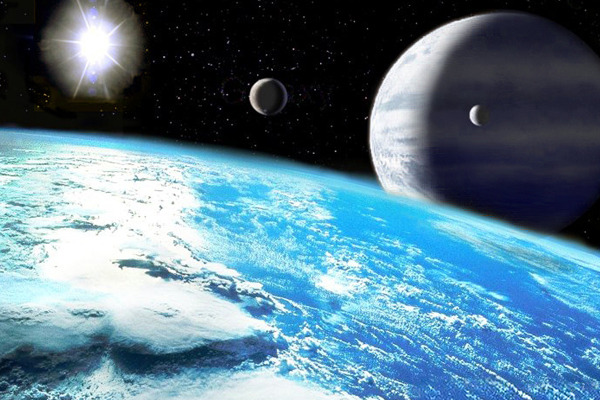Newly Discovered Super-Earth Is 'Best Candidate' For Supporting Life

22 light years away, you'll find a planet which has been given the categorically dull name of GJ 667 Cc, or as it's being emphatically named: The 'super-Earth.' The planet, orbiting a nearby star, has been detected and analysed, with findings giving a solid prediction that it may support life and human inhabitance.
An international team of scientiests discovered the potentially hospitable planet orbiting the star GJ 667 C, via the European Southern Observatory: describing the 'super-Earth' as "the new best candidate to support liquid water and, perhaps, life as we know it."
The planet is measured to be approximately 4.5 times bigger than Earth, and makes a 28.15 day cycle orbit around it's star, receiving 90% as much light as Earth. Much of this sunlight received is also infrared, meaning that the actual energy delivered is equal to that of the light energy. All of this adds to the strong possibility of similar temperatures and conditions to what mankind has become adapted to here on our crazy blue marble.
Of course, however, nowhere near enough data can be collected to make significant conclusions of understanding about the possibilities of atmosphere and water; but while we are all still fascinated at the bewildering question that is 'is there life in space?' We can't help but be excited at the prospects of this.
press release source
New super-Earth detected within the habitable zone of a nearby cool star
Washington, D.C. -- An international team of scientists led by Carnegie's Guillem Anglada-Escudé and Paul Butler has discovered a potentially habitable super-Earth orbiting a nearby star. The star is a member of a triple star system and has a different makeup than our Sun, being relatively lacking in metallic elements. This discovery demonstrates that habitable planets could form in a greater variety of environments than previously believed. Their work will be published by the Astrophysical Journal Letters and the current version of the manuscript will be posted at http://arxiv.org/archive/astro-ph
The team used public data from the European Southern Observatory and analyzed it with a novel data analysis method. They also incorporated new measurements from the Keck Observatory's High Resolution Echelle Spectrograph and the new Carnegie Planet Finder Spectrograph at the Magellan II Telescope.
Their planet-finding technique involved measuring the small wobbles in a star's orbit in response to a planet's gravity. Anglada-Escudé and his team focused on an M-class dwarf star called GJ 667C, which is 22 light years away. It is a member of a triple-star system. The other two stars (GJ 667AB) are a pair of orange K dwarfs, with a concentration of heavy elements only 25% that of our Sun's. Such elements are the building blocks of terrestrial planets so it was thought to be unusual for metal-depleted star systems to have an abundance of low mass planets.
GJ 667C had previously been observed to have a super-Earth (GJ 667Cb) with a period of 7.2 days, although this finding was never published. This orbit is too tight, and thus hot, to support life. The new study started with the aim of obtaining the orbital parameters of this super-Earth.
But in addition to this first candidate, the research team found the clear signal of a new planet (GJ 667Cc) with an orbital period of 28.15 days and a minimum mass of 4.5 times that of Earth. The new planet receives 90% of the light that Earth receives. However, because most of its incoming light is in the infrared, a higher percentage of this incoming energy should be absorbed by the planet. When both these effects are taken into account, the planet is expected to absorb about the same amount of energy from its star that the Earth absorbs from the Sun. This would allow surface temperatures similar to Earth and perhaps liquid water, but this extreme cannot be confirmed without further information on the planet's atmosphere.
"This planet is the new best candidate to support liquid water and, perhaps, life as we know it," Anglada-Escudé said.
The team notes that the system might also contain a gas-giant planet and an additional super-Earth with an orbital period of 75 days. However, further observations are needed to confirm these two possibilities.
"With the advent of a new generation of instruments, researchers will be able to survey many M dwarf stars for similar planets and eventually look for spectroscopic signatures of life in one of these worlds."

